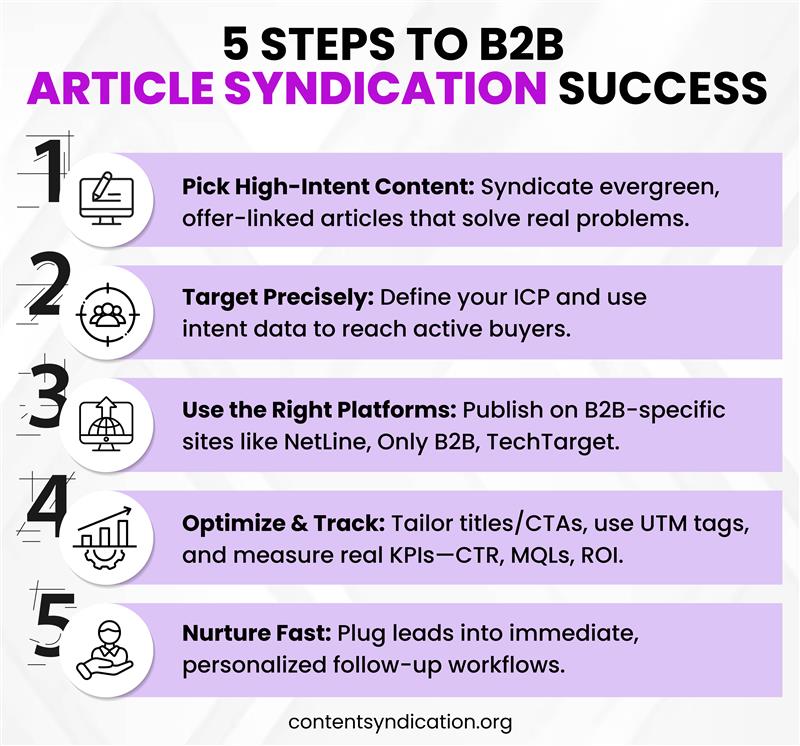Brand awareness, qualified leads, backlinks, or conversions. What do you really expect in return for syndicating your best content?
Most B2B marketers say, “all of the above.”
But those metrics alone don’t guarantee success. You might see thousands of impressions but little engagement. Traffic increases yet leads remain flat.
So, how do you break out of this cycle?
It starts with identifying the metrics that truly matter and learning how to evaluate the real impact of your syndicated content.
Let’s break down the key metrics to measure content syndication one by one.
What are metrics to measure Article Syndication Success.

1. Click-Through Rate (CTR): Are People Engaging at First Glance?
High impressions may look great in a report, but they can be misleading. Seeing thousands of views might feel like a win, but impressions alone don’t prove that your content is resonating with the right audience or any audience at all.
This is why seasoned marketers focus on click-through rate (CTR). A solid CTR means your content didn’t just show up. It grabbed attention and sparked interest.
According to Only B2B, the average CTR for B2B syndicated content is 2.46%. If yours is lower, it may be time to refine your headline, summary, or audience targeting.
If you’re sharing thought leadership content on a platform targeting entry-level professionals, you won’t reach the C-suite. CTR, in this case, becomes more than just a performance metric. It is a measure of relevance.
2. On-Page Engagement: Is the Traffic Meaningful?
You syndicate an article, traffic spikes, and it feels like success. But soon you notice bounce rates rising and conversions standing still. This is the classic “traffic mirage.”
To avoid this, look deeper into user behavior. Metrics like time on page, pages per session, and scroll depth reveal true engagement.
Empty visits with meaningful interaction could be confusing. The goal is not just to get attention. It is to hold it.
Traffic is only valuable when it is relevant and leads to conversion.
3. Lead Quality: Are You Attracting the Right Buyers?
If your campaign brings in 300 leads, that might seem like a big win. But if most of those leads are not qualified, uninterested, or not decision-makers, they are not valuable.
According to ViB Tech, 54% of B2B marketers say improving lead quality and conversion rates is their top challenge with syndication campaigns.Many teams still prioritize lead count over lead intent, which is a mistake.
To solve this, implement lead scoring models. Collaborate with your sales team to define what makes a Marketing Qualified Lead (MQL) or a Sales Qualified Lead (SQL) and apply those criteria to your syndicated sources.
If a partner repeatedly delivers unqualified leads, either refine your targeting or reallocate your budget.
Focusing on lead relevance improves efficiency and gives you a more meaningful return on investment.
4. ROI and Attribution: Is Syndication Delivering Business Value?
Syndication is often undervalued because marketers find it difficult to prove ROI, and leadership questions the spend. In truth, syndication works well when it is tracked properly.
Expecting instant ROI is another common mistake. Syndicated content often works overtime, warming up leads who convert later in the buyer’s journey.
This is why you need a multi-touch attribution model, or at the very least, UTM-tagged campaigns. These help you understand how syndicated content influences conversions across multiple touchpoints.
According to Forbes, 74% of companies say content marketing improves ROI when it is tracked correctly.
To measure true impact, track post-click actions, engagement within nurturing workflows, and sales cycle duration for syndication leads. That is where the real return becomes visible.
5. Backlink Performance: Are You Gaining SEO Value?
While many marketers pursue syndication to drive traffic or generate leads, they often forget the SEO value it brings.
When your content is republished on high-authority websites with proper attribution, it creates powerful backlinks. These improve your domain authority and search engine rankings.
However, many marketers miss this opportunity because they forget to request do-follow backlinks or work with platforms that do not link back at all.
Make backlink inclusion a non-negotiable in your syndication agreements. Then use SEO tools like Ahrefs or SEMrush to monitor whether those links are live, clean, and valuable.
Backlinks are not just an extra bonus. They help fuel long-term organic growth.
6. Data Consistency: Are Your Tracking Systems in Sync?
Reconciling data from syndication platforms, Google Analytics, CRM tools, and automation platforms is difficult. Many marketers rely only on data provided by the syndication partner, without validating it.
This leads to confusion and misses opportunities.
Use at least two analytics platforms to verify results. Standardize your tracking with UTM links across all campaigns. Link these UTMs to contact records in your CRM.
This approach transforms scattered reporting into clear insights. It helps you know which partners, platforms, and formats deliver actual value.
7. Optimization Frequency: Are You Testing and Iterating?
A common myth is that syndication is set-and-forget. You launch the campaign, and then you wait. But the most effective marketers know that performance improves with consistent optimization.
If your CTR is below average or a platform is underperforming, do not wait until the campaign ends. Make changes to mid-flight.
Small updates such as headline tweaks or better targeting filters can deliver big improvements.
Build a habit of reviewing campaign performance weekly. Test often, adapt quickly, and scale what works best.
8. Conversion Metrics: Are You Avoiding Vanity Metrics?
Some metrics may look impressive but mean little in terms of business impact. Impressions, clicks, and downloads are not always tied to revenue.
The problem with chasing vanity metrics is that they can lead you to repeat weak campaigns or misallocate your budget.
Strong syndication strategies are built around revenue-focused metrics such as qualified leads, conversion rates, pipeline progression, and ROI.
Align your KPIs with campaign goals from the start. If your objective is awareness, track CTR and engagement time. If you are focused on generating demand, focus on SQLs and lead-to-opportunity conversion rates.
Your metrics should support your mission. That is how you build a story leadership and sales teams can trust.
Final Thoughts: Make Every Article Count
When measured correctly and optimized regularly, article syndication is a powerful B2B marketing channel. But success requires more than distribution. It demands focus, refinement, and real analysis.
Avoid surface-level assumptions. Look deeper into engagement. Qualify your leads. Test and improve what you are doing. Most importantly, track your results using the right data.
That is how you move from inconsistent results to predictable growth.Let your content work harder. Let every article make an impact.




